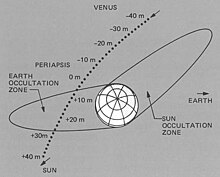
A planetary flyby is the act of sending a space probe past a planet or a dwarf planet close enough to record scientific data.[1] This is a subset of the overall concept of a flyby in spaceflight.
The first flyby of another planet with a functioning spacecraft took place on December 14, 1962, when Mariner 2 zoomed by the planet Venus.[2]
Planetary flybys are commonly used as gravity assist maneuvers to "slingshot" a space probe toward its primary target without expending fuel, but in some cases (such as with New Horizons), flybys are the primary objectives of a mission in of themselves. Flybys modify the direction of the probe and adds to its heliocentric velocity.[3]
A relatively recent example of a flyby spacecraft is New Horizons, which performed flyby maneuvers of Jupiter, Pluto and its moons in the 21st century. The flyby of Jupiter, used as a gravity assist, allowed the craft to reach Pluto at high velocity without the complications of slowing down, after which it proceeded further into the Kuiper Belt on an escape trajectory out of the Solar System.[4]
- ^ "Flyby | Define Flyby at Dictionary.com". Retrieved 2015-07-15.
- ^ "First Planetary Flyby Occurred 50 Years Ago Today". Space.com. 14 December 2012. Retrieved 2015-07-15.
- ^ ANDERSON, J; CAMPBELL, J; NIETO, M (July 2007). "The energy transfer process in planetary flybys". New Astronomy. 12 (5): 383–397. arXiv:astro-ph/0608087. Bibcode:2007NewA...12..383A. doi:10.1016/j.newast.2006.11.004. ISSN 1384-1076.
- ^ Talbert, Tricia (2015-03-25). "New Horizons: The First Mission to the Pluto System and the Kuiper Belt". NASA. Retrieved 2020-07-10.